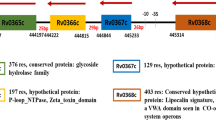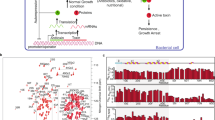Abstract
Our previous report on Bacillus anthracis toxin-antitoxin module (MoxXT) identified it to be a two component system wherein, PemK-like toxin (MoxT) functions as a ribonuclease (Agarwal S et al. JBC 285:7254–7270, 2010). The labile antitoxin (MoxX) can bind to/neutralize the action of the toxin and is also a DNA-binding protein mediating autoregulation. In this study, molecular modeling of MoxX in its biologically active dimeric form was done. It was found that it contains a conserved Ribbon-Helix-Helix (RHH) motif, consistent with its DNA-binding function. The modeled MoxX monomers dimerize to form a two-stranded antiparallel ribbon, while the C-terminal region adopts an extended conformation. Knowledge guided protein–protein docking, molecular dynamics simulation, and energy minimization was performed to obtain the structure of the MoxXT complex, which was exploited for the de novo design of a peptide capable of binding to MoxT. It was found that the designed peptide caused a decrease in MoxX binding to MoxT by 42% at a concentration of 2 μM in vitro. We also show that MoxX mediates negative transcriptional autoregulation by binding to its own upstream DNA. The interacting regions of both MoxX and DNA were identified in order to model their complex. The repressor activity of MoxX was found to be mediated by the 16 N-terminal residues that contains the ribbon of the RHH motif. Based on homology with other RHH proteins and deletion mutant studies, we propose a model of the MoxX–DNA interaction, with the antiparallel β-sheet of the MoxX dimer inserted into the major groove of its cognate DNA. The structure of the complex of MoxX with MoxT and its own upstream regulatory region will facilitate design of molecules that can disrupt these interactions, a strategy for development of novel antibacterials.












Similar content being viewed by others
Abbreviations
- TA:
-
Toxin-antitoxin
- RHH:
-
Ribbon-helix-helix
- ORF:
-
Open reading frame
- CD:
-
Circular dichroism
- aa:
-
Amino acids
- RFI:
-
Relative fluorescence intensity
- MD:
-
Molecular dynamics
- EM:
-
Energy minimization
References
Jensen RB, Gerdes K (1995) Programmed cell death in bacteria: proteic plasmid stabilization systems. Mol Microbiol 17:205–210
Gerdes K, Christensen SK, Lobner-Olesen A (2005) Prokaryotic toxin-antitoxin stress response loci. Nat Rev Microbiol 3:371–382
Gerdes K, Rasmussen PB, Molin S (1986) Unique type of plasmid maintenance function: postsegregational killing of plasmid-free cells. Proc Natl Acad Sci USA 83:3116–3120
Aizenman E, Engelberg-Kulka H, Glaser G (1996) An E. coli chromosomal ‘addiction module’ regulated by guanosine 3′–5′-bispyrophosphate: a model for programmed bacterial cell death. Proc Natl Acad Sci USA 93:6059–6063
Brooun A, Songhua L, Lewis K (2000) A dose-response study of antibiotic resistance in Pseudomonas aeruginosa biofilms. Antimicrob Agents Chemother 44:640–646
Agarwal S, Agarwal S, Bhatnagar R (2007) Identification and characterization of a novel toxin-antitoxin module from Bacillus anthracis. FEBS Lett 581:1727–1734
Agarwal S, Mishra NK, Bhatnagar S, Bhatnagar R (2010) PemK toxin of Bacillus anthracis is a ribonuclease: an insight into its active site, structure and function. J Biol Chem 285:7254–7270
De Jonge N, Garcia-Pino A, Buts L, Haesaerts S, Charlier D, Zangger K, Wynes L, De Greve H, Loris R (2009) Rejuvenation of CcdB-poisoned gyrase by an intrinsically disordered protein domain. Mol Cell 35:154–163
Oberer M, Zangger K, Gruber K, Keller W (2007) The solution structure of ParD, the antidote of the ParDE toxin–antitoxin module, provides the structural basis for DNA and toxin binding. Protein Sci 16:1676–1688
Raumann BE, Rould MA, Pabo CO, Sauer RT (1994) DNA recognition by β-sheets in the Arc repressor-operator crystal structure. Nature 367:754–757
Gomis-Ruth FX, Sola M, Acebo P, Parraga A, Guasch A, Gonzalez EritigaR, Espinosa M, del Solar G, Coll M (1998) The structure of plasmid-encoded transcriptional repressor CopG unliganded and bound to its operator. EMBO J 17:7404–7415
Somers WS, Philips SE (1992) Crystal structure of the met repressor-operator complex at 2.8 Å resolution reveals DNA recognition by β-strands. Nature 359:387–393
Schreiter ER, Sintchak MD, Guo Y, Chivers PT, Sauer RT, Drennan CL (2003) Crystal structure of the nickel-responsive transcription factor NikR. Nat Struct Biol 10:794–799
Kamada K, Hanoaka F, Burley SK (2003) Crystal structure of MazE/MazF complex: molecular bases of antidote-toxin recognition. Mol Cell 11:875–884
Madl T, Melderen VM, Mine N, Respondek M, Oberer M, Keller W, Khatai L, Zangger K (2006) Structural basis for nucleic acid and toxin recognition of the bacterial antitoxin CcdA. J Mol Biol 364:170–185
Li GY, Zhang Y, Inouye M, Ikura M (2008) Structural mechanism of transcripitional autorepression of the E. coli RelB/RelE antitoxin/toxin module. J Mol Biol 380:107–119
Schreiter ER, Wang SC, Zamble DB, Drennan CL (2006) NikR-operator complex structure and the mechanism of repressor activation by metal ions. Proc Natl Acad Sci USA 103:13676–13681
Mattison K, Wilbur JS, So M, Brennan RG (2006) Structure of FitAB from Neisseria gonorrhoeae bound to DNA reveals a tetramer of toxin-antitoxin heterodimers containing pin domains and ribbon-helix-helix motifs. J Biol Chem 281:37942–37951
Kedzierska B, Lian L, Hayes F (2007) Toxin–antitoxin regulation: bimodal interaction of YefM–YoeB with paired DNA palindromes exerts transcriptional autorepression. Nucleic Acids Res 35:325–339
Gogos A, Mu H, Bahna F, Gomez CA, Shapiro L (2003) Crystal structure of YdcE protein from Bacillus subtilis. Proteins 53:320–322
Andrade MA (1993) Evaluation of secondary structure of proteins from UV circular dichroism spectra using an unsupervised learning neural network. Protein Eng 6:383–390
Fiser A, Do RK, Sali A (2000) Modeling of loops in protein structure. Protein Sci 9:1753–1773
Laskowski RA, MacArthur MW, Moss DS, Thornton JM (1993) PROCHECK: a program to check the stereochemical quality of protein structures. J Appl Crystallogr 26:283–291
Marchler-Bauer A, Anderson JB, Chitsaz F, Derbyshire MK, DeWeese-Scott C, Fong JH, Geer LY, Geer RC, Gonzales NR, Gwadz M, He S, Hurwitz DI, Jackson JD, Ke Z, Lanczycki CJ, Liebert CA, Liu C, Lu F, Lu S, Marchler GH, Mullokandov M, Song JS, Tasneem A, Thanki N, Yamashita RA, Zhang D, Zhang N, Bryant SH (2009) CDD: specific functional annotation with the Conserved Domain Database. Nucleic Acids Res 37:D205–D210
Kelly LA, Sternberg MJE (2009) PHYRE:Protein structure prediction on the web: a case study using the PHYRE server. Nat Protoc 4:363–371
Söding J (2005) Protein homology detection by HMM-HMM comparison. Bioinformatics 21:951–960
Hall TA (1999) BIOEDIT, a user-friendly biological sequence alignment editor and analysis program for Windows 95/98/NT. Nucleic Acids Symp Ser 41:95–98
Arnold K, Bordoli L, Kopp J, Schwede T (2006) The SWISS-MODEL workspace: a web-based environment for protein structure homology modeling. Bioinformatics 22:195–201
Guex N, Peitsch MC (1997) SWISS-MODEL and the Swiss-PdbViewer: an environment for comparative protein modeling. Electrophoresis 18:2714–2723
Tovchigrechko A, Vakser IA (2006) GRAMM-X public web server for protein-protein docking. Nucleic Acids Res 34:W310–W314
Pearlman DA, Case DA, Caldwell JW, Ross WS, Cheatham TE III, DeBolt S, Ferguson D, Seibel G, Kollman P (1995) AMBER, a package of computer programs for applying molecular mechanics, normal mode analysis, molecular dynamics and free energy calculations to simulate the structural and energetic properties of molecules. Comput Phys Commun 91:1–41
Darden T, York D, Pederson L (1993) Particle Mesh-Ewald method: an N-log (N) method for ewald sums in large systems. J Chem Phys 98:10089–10092
Fung HK, Welsh WJ, Floudas CA (2008) Computational de novo peptide and protein design: rigid templates versus flexible templates. Ind Engin Chem Res 47:993–1001
Maupetit J, Derreumaux P, Tuffery P (2009) PEP-FOLD: an online resource for de novo peptide structure prediction. Nucleic Acids Res 37(suppl 2):W498–W503
Raveh B, London N, Schueler-Furman O (2010) Sub-angstrom modeling of complexes between flexible peptides and globular proteins. Proteins 78:2029–2040
Cutting SM, Vander Horn PB (1990) Genetic analysis. In: Harwood CR, Cutting SM (eds) Molecular biological methods for Bacillus. Wiley, UK, pp 27–74
Van Dijk M, Bonvin AM (2009) 3D-DART: a DNA structure modeling server. Nucleic Acid Res 37:W235–W239
Schlessinger A, Punta M, Yachdav G, Kajan L, Rost B (2009) Improved disorder prediction by combination of orthogonal approaches. PLoS One 4:e4433
Kamphuis MB, Monti MC, van den Heuvel RH, López-Villarejo J, Díaz-Orejas R, Boelens R (2007) Structure and Function of bacterial Kid-Kis and related toxin-antitoxin systems. Protein Pept Lett 14:113–124
Chivers PT, Tahirov TH (2005) Structure of Pyrococcus horikoshii NikR: nickel sensing and implications for the regulation of DNA recognition. J Mol Biol 348:597–607
Dian C, Schauer K, Kapp U, McSweeney SM, Labigne A, Terradot L (2006) Sructural basis of the nickel response in Helicobacter pylori: crystal structures of HpNikR in Apo and nickel bound states. J Mol Biol 361:715–730
Ananthraman V, Aravind L (2003) New connections in the prokaryotic toxin-antitoxin network: relationship with the eukaryotic nonsense-mediated RNA decay system. Genome Biol 4:R81
Wilbur JS, Chivers PT, Mattison K, Potter L, Brennan RG, So M (2005) Neisseria gonorrhoeae FitA interacts with FitB to bind DNA through its ribbon-helix-helix motif. Biochemistry 44:12515–12524
Weihofen WA, Cicek A, Pratto F, Saenger W (2006) Structures of omega repressors bound to direct and inverted DNA repeats explain modulation of transcription. Nucleic Acids Res 34:1450–1458
Acknowledgments
Authors would like to acknowledge Prof. B. Jayaram for providing access to Super Computing Facility for Bioinformatics and Computational Biology, IIT (Delhi) for running MD simulations. We also acknowledge the help of Barak Raveh and Ora Schueler-Furman at the Hebrew University, Jerusalem for enabling exhaustive runs of FlexPepDock simulations on their server and for their valuable inputs. N.C. acknowledges University Grants Commission and Council of Scientific and Industrial Research for providing financial assistance.
Author information
Authors and Affiliations
Corresponding authors
Electronic supplementary material
Below is the link to the electronic supplementary material.
Figure S1
Superposition of MoxXT complex with CcdAB (3HPW). The toxin dimers of the TA complexes were superimposed and are shown here (MoxT in cyan and CcdB in orange). The C-terminus (residues 40–72) of CcdA are shown in yellow while the two chains of MoxX dimer are shown in pink and purple (TIFF 20328 kb)
Rights and permissions
About this article
Cite this article
Chopra, N., Agarwal, S., Verma, S. et al. Modeling of the structure and interactions of the B. anthracis antitoxin, MoxX: deletion mutant studies highlight its modular structure and repressor function. J Comput Aided Mol Des 25, 275–291 (2011). https://doi.org/10.1007/s10822-011-9419-z
Received:
Accepted:
Published:
Issue Date:
DOI: https://doi.org/10.1007/s10822-011-9419-z




